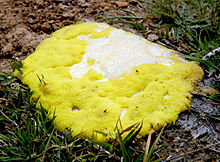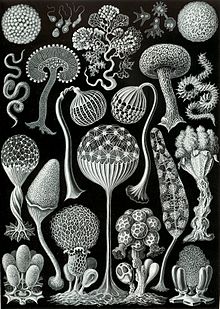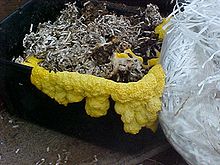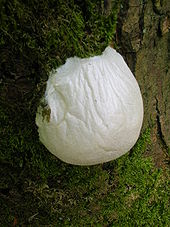- Slime mold
-
Not to be confused with slime bacteria.
 Slime mold Stemonitis fusca in Scotland, UK
Slime mold Stemonitis fusca in Scotland, UK
 Fuligo septica, the "dog vomit" slime mold
Fuligo septica, the "dog vomit" slime mold
 Mycetozoa from Ernst Haeckel's 1904 Kunstformen der Natur (Artforms of Nature)
Mycetozoa from Ernst Haeckel's 1904 Kunstformen der Natur (Artforms of Nature)
Slime mold or mould is a broad term describing protists that use spores to reproduce. Slime molds were formerly classified as fungi, but are no longer considered part of this kingdom.[1]
Their common name refers to part of some of these organisms' life cycles where they can appear as gelatinous "slime". This is mostly seen with the myxomycetes, which are the only macroscopic slime molds.
Slime molds have been found all over the world and feed on microorganisms that live in any type of dead plant material. For this reason, these organisms are usually found in soil, lawns, and on the forest floor, commonly on deciduous logs. However, in tropical areas they are also common on inflorescences, fruits and in aerial situations (e.g., in the canopy of trees) and also grow in air conditioners, especially when the drain is blocked. In urban areas, they are found on mulch or even in the leaf mold in gutters. One of the most commonly encountered slime molds is the yellow Physarum polycephalum, found both in nature in forests in temperate zones, as well as in classrooms and laboratories.
Most slime molds are smaller than a few centimeters, but some species may reach sizes of up to several square meters and masses of up to 30 grams.[2] Many have striking colours such as yellow, brown and white.
Contents
Taxonomy
Slime molds can generally be divided into two main groups.
- A plasmodial slime mold involves numerous individual cells attached to each other, forming one large membrane. This "supercell" (a syncytium) is essentially a bag of cytoplasm containing thousands of individual nuclei. See heterokaryosis.
- By contrast, cellular slime molds spend most of their lives as individual unicellular protists, but when a chemical signal is secreted, they assemble into a cluster that acts as one organism.
Slime molds, as a group, are polyphyletic. They were originally represented by the subkingdom Gymnomycota in the Fungi kingdom and included the defunct phyla Myxomycota, Acrasiomycota and Labyrinthulomycota. Today, slime molds have been divided between several supergroups, none of which are included in the kingdom Fungi.
In more strict terms, slime molds comprise the group of the mycetozoans (myxomycetes, dictyostelids and protostelids). However, even at this level there are conflicts to be resolved. Recent molecular evidence shows that the first two groups are likely to be monophyletic; however the protostelids seem to be polyphyletic, too. For this reason, scientists are currently trying to understand the relationships among these three groups.
Bikont
- Acrasiomycota: slime molds which belong to the Heterolobosea within the super group Excavata. They have a similar life style to Dictyostelids, but their amoebae behave differently, having eruptive pseudopodia.
- Labyrinthulomycota: slime nets which belong to the super group Chromalveolata as the class Labyrinthulomycetes. They are marine and form labyrinthine networks of tubes in which amoeba without pseudopods can travel.
- Plasmodiophorids: parasitic protists which belong to the super group Rhizaria. They can cause cabbage club root disease and powdery scab tuber disease. The Plasmodiophorids also form coenocytes but are internal parasites of plants (e.g., Club root disease of cabbages).
Amoebozoa
- Mycetozoa, which includes the defunct phylum Myxomycota, belong to the supergroup Amoebozoa and include:
- Myxogastria or myxomycetes : syncytial or plasmodial slime molds
- Dictyosteliida: unicellular slime molds or dictyostelids.
- Protostelids.
The most commonly encountered are the Myxogastria. A common slime mold which forms tiny brown tufts on rotting logs is Stemonitis. Another form which lives in rotting logs and is often used in research is Physarum polycephalum. In logs it has the appearance of a slimy web-work of yellow threads, up to a few feet in size. Fuligo forms yellow crusts in mulch.
The Dictyosteliida, cellular slime molds, are distantly related to the plasmodial slime molds and have a very different lifestyle. Their amoebae do not form huge coenocytes, and remain individual. They live in similar habitats and feed on microorganisms. When food runs out and they are ready to form sporangia, they do something radically different. They release signal molecules into their environment, by which they find each other and create swarms. These amoeba then join up into a tiny multicellular slug-like coordinated creature, which crawls to an open lit place and grows into a fruiting body. Some of the amoebae become spores to begin the next generation, but some of the amoebae sacrifice themselves to become a dead stalk, lifting the spores up into the air.
The Protostelids have characters intermediate between the previous two groups, but they are much smaller, the fruiting bodies only forming one to a few spores.
Opisthokont
Fonticula is a cellular slime mold which forms a fruiting body in a volcano shape.[3] Fonticula is not closely related to either the Dictyosteliida or the Acrasidae.[4] A 2009 paper finds it to be related to Nuclearia, which in turn is related to fungi.[5]
Life cycle
Slime molds begin life as amoeba-like cells. These unicellular amoebae are commonly haploid and multiply if they encounter their favorite food, bacteria. These amoebae can mate if they encounter the correct mating type and form zygotes which then grow into plasmodia. These contain many nuclei without cell membranes between them, which can grow to be meters in size. One variety is often seen as a slimy yellow network in and on rotting logs. The amoebae and the plasmodia engulf microorganisms. The plasmodium grows into an interconnected network of protoplasmic strands.[6]
Within each protoplasmic strand the cytoplasmic contents rapidly stream. If one strand is carefully watched for about 50 seconds the cytoplasm can be seen to slow, stop, and then reverse direction. The streaming protoplasm within a plasmodial strand can reach speeds of up to 1.35 mm per second which is the fastest rate recorded for any micro-organism.[7] Migration of the plasmodium is accomplished when more protoplasm streams to advancing areas and protoplasm is withdrawn from rear areas. When the food supply wanes, the plasmodium will migrate to the surface of its substrate and transform into rigid fruiting bodies. The fruiting bodies or sporangia are what we commonly see; they superficially look like fungi or molds but are not related to the true fungi. These sporangia will then release spores which hatch into amoebae to begin the life cycle again.[6]
Plasmodia
In Myxomycetes, the plasmoidal portion of the life cycle only occurs after syngamy, which is the fusion of cytoplasm and nuclei of myxoamoebae or swarm cells. Therefore, all of the nuclei are diploid at this stage and mitosis occurs simultaneously throughout the organism. Myxomycete plasmodia are multinucleate masses of protoplasm that move by cytoplasmic streaming. In order for the plasmodium to move, cytoplasm must be diverted towards the leading edge from the lagging end. This process results in the plasmodium advancing in fan-like fronts. As it moves, plasmodium also gains nutrients through the phagocytosis of bacteria and small pieces of organic matter.
The Myxomycete plasmodium also has the ability to subdivide and establish separate plasmodia. Conversely, separate plasmodia that are genetically similar and compatible can fuse together to create a larger plasmodium. In the event that conditions become dry, the plasmodium will form a sclerotium, essentially a dry and dormant state. In the event that conditions become moist again the sclerotium absorbs water and an active plasmodium is restored. When the food supply wanes, the Myxomycete plasmodium will enter the next stage of its life cycle forming haploid spores, often in a well-defined sporangium or other spore-bearing structure.
Behavior
Slime molds show interesting behavior. When a slime mold mass or mound is physically separated, the cells find their way back to re-unite. Studies on Physarum have even shown an ability to learn and predict periodic unfavorable conditions in laboratory experiments (Saigusa et al 2008)[8] [9] Professor John Tyler Bonner, who has spent a lifetime studying slime molds argues that Slime molds are "no more than a bag of amoebae encased in a thin slime sheath, yet they manage to have various behaviors that are equal to those of animals who possess muscles and nerves with ganglia -- that is, simple brains."
In popular culture
- Traditional Finnish lore describes how malicious witches used yellow Fuligo (there called "paranvoi," or butter of the familiar) to spoil milk.
- Mycologist Tom Volk reports that the plasmodium of Fuligo is eaten in Mexico.[10]
- The webcomic GPF has as main characters two sentient, talking slime molds by the names of Frederick Physarum and Persephone.
- The computer game NetHack has Slime Mold as an edible, re-nameable fruit. This is an homage to the earlier game Rogue, which featured Slime Molds the adventurer could find and add to inventory/eat. When a slime mold was eaten, the message displayed was "My, that was a yummy Slime Mold!"
- The giant amoeba-like alien that terrorizes the small community of Downingtown, Pennsylvania, in the 1958 American horror/science-fiction film The Blob might be based on slime molds.[11]
- The lead character in AMC's series Rubicon," Will Travers, gives a quick description of slime mold behavior as a dinner topic at his boss' house in Episode 6.[12]
- In the TV special The Future Is Wild, the Slither Sucker is based on slime molds.[citation needed]
See also
- Dictyostelium
- Mycetozoa
- Sorocarp
- Swarming motility
References
- ^ "Introduction to the "Slime Molds"". University of California Museum of Paleontology. http://www.ucmp.berkeley.edu/protista/slimemolds.html. Retrieved 2009-04-04.
- ^ "Zinc Accumulation by the Slime Mold Fuligo septica (L.) Wiggers in the Former Soviet Union and North Korea". http://jeq.scijournals.org/cgi/content/full/31/3/1038. Retrieved 12 December 2009.
- ^ Mary C. Deasey and Lindsay S. Olive (31 July 1981), "Role of Golgi Apparatus in Sorogenesis by the Cellular Slime Mold Fonticula alba", Science 213 (4507): 561–563, doi:10.1126/science.213.4507.561
- ^ Ann C. Worley, Kenneth B. Raper and Marianne Hohl (Jul. - Aug., 1979), "Fonticula alba: A New Cellular Slime Mold (Acrasiomycetes)", Mycologia 71 (4): 746–760, doi:10.2307/3759186, http://www.jstor.org/stable/3759186
- ^ Matthew W. Brown, Frederick W. Spiegel and Jeffrey D. Silberman (2009), "Phylogeny of the "Forgotten" Cellular Slime Mold, Fonticula alba, Reveals a Key Evolutionary Branch within Opisthokonta", Molecular Biology and Evolution 26 (12): 2699–2709, doi:10.1093/molbev/msp185, PMID 19692665
- ^ a b Ling, H. 1999. "Myxomycetes, Commonly Overlooked Plants" The Native Plant Society of NJ Newsletter, Fall p5.
- ^ Alexopolous, C.J. 1962, second edition. "Introductory Mycology" John Wiley and Sons, p. 78.
- ^ Saigusa , T et al Amoebae Anticipate Periodic Events. Hokkaido University PRL 100,018101 (2008)
- ^ http://discovermagazine.com/2009/jan/071
- ^ Tom Volk. "Fuligo septica, the dog vomit slime mold, Tom Volk's Fungus of the Month for June 1999". Tom Volk's Fungi. http://botit.botany.wisc.edu/toms_fungi/june99.html. Retrieved 2009-11-13.
- ^ Bradford Condon. "Beware! The Slime Mold!". Cornell Mushroom Blog. http://blog.mycology.cornell.edu/?p=267. Retrieved 2009-11-13.
- ^ "Rubicon". imdb.com. http://www.imdb.com/title/tt1389371/. Retrieved 2010-08-30.
External links
- Slime Molds
- Slime Mould Solves Maze Puzzle from abc.net.au
- Slime Mould duplicates Rail Networks from The Economist
- Designing highways the slime mould way from New Scientist
- Hunting Slime Molds from Smithsonian Magazine
- "Robot Piloted by a Slime Mold". Slashdot. 2006. http://hardware.slashdot.org/article.pl?sid=06/02/14/0354241. Retrieved February 15, 2006.
- dictyBase is an online informatics resource for Dictyostelium, a cellular slime mould.
- Beautiful Slime Mold Slime Mold Macro Photography Shots
- nomen.eumycetozoa.com is an online nomenclatural information system of slime moulds (Myxomycetes, Dictyostelids and Protostelids) of the world.
- good photo gallery
- Slime Mold Photos Life cycle of Reticularia splendens at MushroomMania.net.
- Slime Moulds - Dictyoselium, (ABC Radio - Australia) [1]
Eukaryota Bikonta AH/SARAHSARHalvariaHeterokont ("S")Unikonta Apusomonadida (Apusomonas, Amastigomonas) · Ancyromonadida (Ancyromonas) · Hemimastigida (Hemimastix, Spironema, Stereonema)HolozoaDermocystida · IchthyophonidaFilozoaFilastereaCapsaspora · MinisteriaChoanoflagellateaCategories:- Protista
- Amoeboids
- Slime molds
Wikimedia Foundation. 2010.



